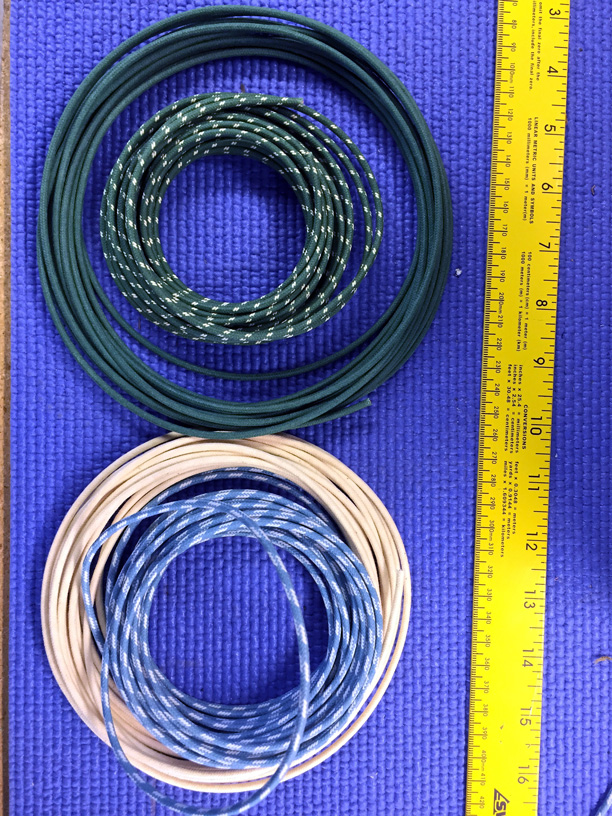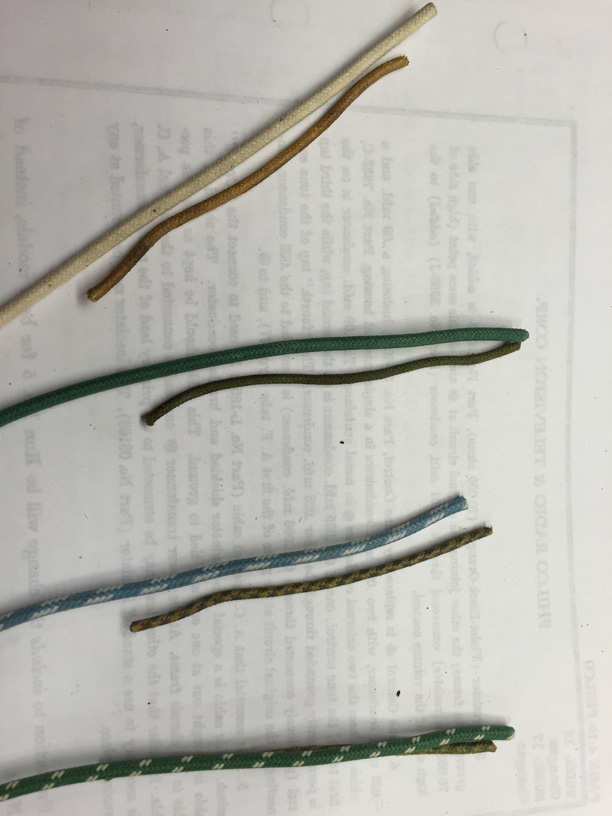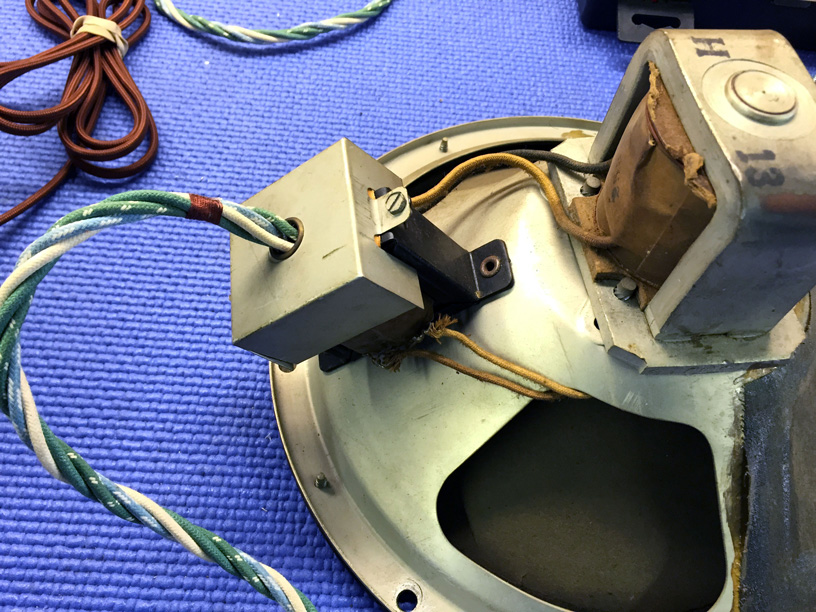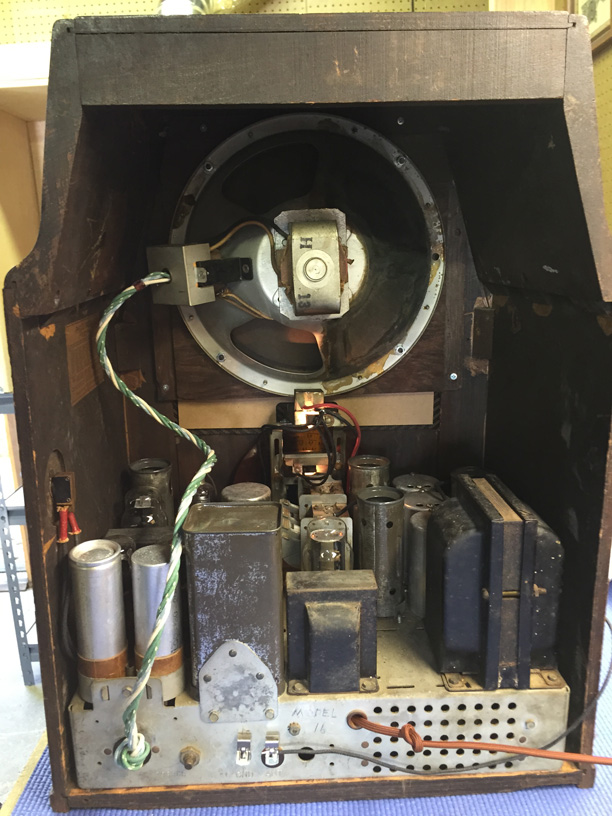Posts: 1,889
Threads: 214
Joined: May 2015
City: Seattle
State, Province, Country: WA
[DISCLAIMER: this worked for me but the wire mentioned here is *rated* at 50V - which means it is only tested by the manufacturer to that voltage]
Most of the Philcos I've repaired have wire harnesses to connect to the speaker. Often these wires aren't in great shape (missing insulation, patched with electrical tape) so of course I replace them with new cloth-covered wire. That gets the job done, but it doesn't look exactly like the original harness.
As an example, the original wire harness colors on my 16B tombstone: - white
- green
- green & white
- blue & white
With only solid colors to play with this means I have to add two additional colors to the 'look' of the back. 
I searched far and wide to see what kind of reproduction striped wire might be out there and came across Rhode Island Wiring Service - a small company that caters to antique automobile restoration. They manufacturer a wide variety of wire styles - but most are heavier gauge than those used in antique radios. I decided to take the plunge and order 25' in the closest style for each of my 16B's original colors (the wire cost 0.25/ft.):
18BPW 18ga Braided Primary Wire BU-4W
18BPW 18ga Braided Primary Wire W
18BPW 18ga Braided Primary Wire GN
18BPW 18ga Braided Primary Wire GN-2W
Decoder ring:
BU-4W = blue wire, 4 white tracers - kind of looks like original blue/white pattern
I would have preferred GN-4W = green wire, 4 white tracers, but they were out of that so I had to settle for GN-2W.
Anyway, here's what arrived in the mail:

And a side-by-side comparison between the old and new wire:

I created a new wire harness by measuring out 36" of each color and twisting them together. I then tied each end with a number of turns of brown thread bonded together with hot glue. Here's a comparison:

and the final result:


Posts: 13,776
Threads: 580
Joined: Sep 2005
City: Ferdinand
State, Province, Country: Indiana
--
Ron Ramirez
Ferdinand IN
Posts: 1,703
Threads: 55
Joined: Sep 2005
City: Evanston, IL
Yes, yes.  
Great resource, thanks!
Chuck
Posts: 2,118
Threads: 112
Joined: Jun 2010
City: Medford OR (OR what?)
I have spoken with several of these vendors. Better check the voltage rating. The ones I checked on were only 32V.
"I just might turn into smoke, but I feel fine"
http://www.russoldradios.com/
Posts: 1,889
Threads: 214
Joined: May 2015
City: Seattle
State, Province, Country: WA
Ah - good question Phlogiston. I have emailed to check.
The wire itself is constructed as cloth outer jacket and plastic insulation underneath. If it is rated 32V that seems incredibly low - is this a case of not having it rated above 32V since it is intended to be used for automobile applications?
In general, what maximum voltage can we expect for the speaker harness wires on a typical set?
Posts: 126
Threads: 13
Joined: Sep 2013
City: Milwaukee, Wisconsin
Considering at least 2 of those wires connect to the field coil, which is usually right off the rectifier, you can expect to see probably 300+ depending on the set.
Posts: 2,353
Threads: 92
Joined: May 2010
City: Clayton, NC
Most DC systems carry more current than our radios. Without further research, which would still be an important reassurance, I would think that these wires would do fine in our antique radio restos.
Posts: 126
Threads: 13
Joined: Sep 2013
City: Milwaukee, Wisconsin
(07-22-2015, 11:38 AM)TA Forbes Wrote: Most DC systems carry more current than our radios. Without further research, which would still be an important reassurance, I would think that these wires would do fine in our antique radio restos.
I always thought insulation was most important as far voltage is concerned. And wire size/gauge was most important where current was concerned.
Posts: 1,889
Threads: 214
Joined: May 2015
City: Seattle
State, Province, Country: WA
Here is the reply from Rhode Island Wire:
Quote:Hi Nathan
The folks that make the wire probably know the material to use and thickness needed to get it rated where they want it. I doubt they test every batch, but I'm sure they check to make sure often enough and it's likely rated over 50 and they feel safe calling it "Rated for 50 Volt".
We buy the plastic wire, and put cloth on it. Not sure of their safety procedures or even their manufacturing process, but they must be trustworthy or they'd be out of business.
Now, you are not the first person looking for this stuff.
Here is what some folks do.
You purchase at least 300 feet of the required wire rated proper for your Radio Application.
We can cover it with cloth and saturate it to keep the cloth on and make it fire resistant.
There must be at least 300 feet to string the machine up.
I've added a 'your mileage may vary' warning to the top of my post.
I wonder if this is something that a company like Radio Daze would want to supply?
Another alternative would be to set up a kickstarter and gauge (heh) interest in people who'd commit to buying some amount of it.
Posts: 1,411
Threads: 72
Joined: Oct 2007
City: Linn Creek, MO
It looks to me like your new wire has as much insulation as the original wire. I wouldn't worry about.
Steve
M R Radios C M Tubes
Posts: 264
Threads: 51
Joined: Aug 2014
City: San Antonio, TX
I'm looking at a competitor who has posted a gauge/amps chart for their wire. Amps rang from 50 amps to 16 amps. Gauges range from #10 through #18.
Charlie in San Antonio
Posts: 1,889
Threads: 214
Joined: May 2015
City: Seattle
State, Province, Country: WA
As Nick3092 mentioned, the insulation material and thickness would have more to do with the voltage rating. The conductor gauge and material would affect how much current the wire can safely carry without heating up too much.
As a means for making some quantitative comparisons of the insulation material I took some measurements with my handy digital calipers:
Code: Philco Original Rhode Island Wire Radio Daze W6ST-18-25
Diameter 2.27mm 2.90mm 3.41mm
Gauge 22ga 18ga 18ga
Insulation 0.52mm (rubber?) 0.81mm (plastic) 0.96mm (plastic)
Jacket 0.35mm (cloth) 0.37mm (cloth) 0.36mm (cloth)
The Radio Daze wire serves as the reference wire since it is rated at 600V and is the same wire gauge as the Rhode Island wire.
Of course the physical dimensions don't tell the whole story. Here are listed dielectric strengths extracted from the CRC Handbook of Chemistry:
thermoplastic polymers (polypropylene, polystyrene): 15.0 - 23.6 kV/mm
extrusion compounds (polyethylene, polyvinyl chloride): 11.8 - 18.9 kV/mm
natural rubber: 100-215 kV/mm
butyl rubber: 23.6 kV/mm
neoprene: 15.7-27.6 kV/mm
silicone rubber: 26-36 kV/mm
mica: 118 kV/mm
So the insulating material makes a huge difference. If the original wire really is rubber coated internally that probably explains why it is sufficient for high voltages even though it is small by comparison. Even for the new wires, the specific plastic used makes a difference.
Even if we assume that the new wire's insulation has a strength of 11.8 kV/mm (the lowest of the listed plastic insulators) then it would be expected to break down around 11.8 kV/mm * 0.81mm = 9.558kV = 956V. This also ignores the insulating effect of the cotton jacket.
Based on these back of the envelope calculations I think I feel OK using them for my own restoration projects.
Posts: 181
Threads: 0
Joined: Mar 2008
City: Pocasset, MA
Posts: 2,353
Threads: 92
Joined: May 2010
City: Clayton, NC
Yes, agree about insulation. My point was the conductor itself being able to carry the current found in most sets that we would be working.
VERY nice info about insulation. BZ !!!
Users browsing this thread: 1 Guest(s)
|
|
Recent Posts
|
|
Philco 46-480 Electronic Restoration
|
| Haha, thank you sir! I’ve been eyeballing a 47-1230 console for sale over north of Bentonville, Arkansas for a while. Pr...jrblasde — 09:18 PM |
|
Philco 46-480 Electronic Restoration
|
| @ Joseph, get off the porch and run with the dogs. You fixed one, grab another. @ Morzh, I think that we are the same ...MrFixr55 — 08:59 PM |
|
Philco Model 249 made in England
|
| Wow! Now that is something! I’ve never seen a Philco like that, but it’s pretty mid-century.jrblasde — 06:40 PM |
|
Philco 46-480 Electronic Restoration
|
| I've run the radio for a couple of hours today, and all is well. It's a remarkable sounding radio! I'll go ahead and upl...jrblasde — 06:05 PM |
|
Philco Model 249 made in England
|
| Gary - Thanks for responding! I hadn't actually taken possession of it at the time of my post but since you said it was...fklown — 03:32 PM |
|
Philco model 40-100
|
| Marion;
Replacing volume controls was something some service shops did in years gone by to make a little extra profit...Arran — 03:24 PM |
|
Philco Model 249 made in England
|
| Welcome to the Phorum, fklown! That's one heck of a Philco 'yardstick' you've got there! Could you possibly post a clo...GarySP — 03:19 PM |
|
Philco model 40-100
|
| Arran,
Thank you so much for your assistance and the link to the fleabay listing! They say a picture is worth a thousan...mhamby — 01:43 PM |
|
Philco Model 249 made in England
|
| I wonder if anyone has any information or experience with this model. My internet searches are coming up with nothing. ...fklown — 11:40 AM |
|
Road Trip for a Philco 46-480
|
| Good morning, folks! I’ve finished the cabinet and the electrical restoration, and have detailed those in their respecti...jrblasde — 10:56 AM |
|
Who's Online
|
There are currently 465 online users. [Complete List]
» 1 Member(s) | 464 Guest(s)
|
|
|

|
 
|









![[-] [-]](https://philcoradio.com/phorum/images/bootbb/collapse.png)


